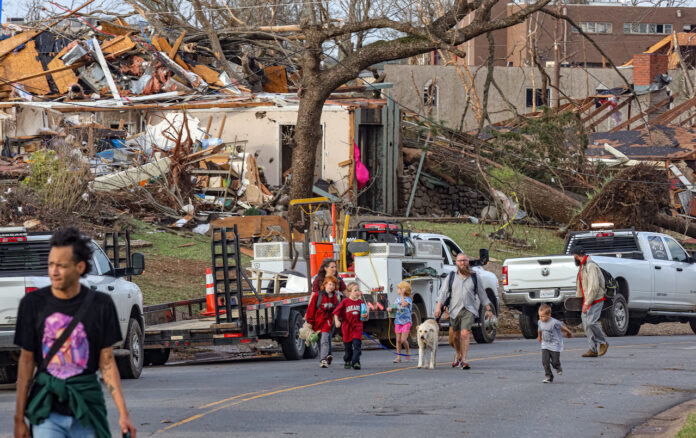North Little Rock, AR (4/2/2023) — The first death was reported in the city of North Little Rock in a tornado that struck a little after 2 p.m. Friday; four were killed in Wynne, about 105 miles northeast of Little Rock, in a tornado that hit about 4:30 p.m.
Wynne Mayor Jennifer Hobbs used the City Hall Facebook page to update residents on the status of recovery efforts and location of shelters and feeding centers. Like many other groups, the Rural Caucus of Arkansas issued an “urgent call for aid” seeking a variety of equipment and other supplies to assist recovery crews.
Little Rock officials and citizens used city government’s Facebook page for updates as well.
Gov. Sarah Huckabee Sanders and Little Rock Mayor Frank Scott Jr. toured heavily damaged west Little Rock neighborhoods Saturday morning and held a brief press conference in front of Fire Station No. 9, which also sustained damage.
The two praised firefighters, law enforcement, emergency medics and other first responders for their “heroic” actions during and after the tornado.
Sanders tweeted Saturday afternoon about the destruction of Wynne High School and offered her administration’s assistance.
Dozens of churches, nonprofits, businesses and individuals took to Twitter Saturday to offer emergency supplies and other assistance to those displaced by the storm or to collect clothing, nonperishable foods and other items.
In a Friday night press conference, Scott told residents: “We are here for you. We’ve got your back.”
“People come first. Paperwork comes second,” Sanders said.
Sanders said she’d activated the Arkansas National Guard and had about 100 troops on the ground in the capital city and Wynne to assist local authorities in recovery efforts and assessing damage. Sanders also said she’d been in touch with the Federal Emergency Management Agency, which promised quick action.
Meanwhile, the governor said she’d allocated $250,000 for state and local emergency management agencies to help with the situation.
Scott called the tornado “devastating,” and Assistant Police Chief Andre Dyer described it as “horrific.”
“It breaks the heart to see people displaced,” Scott said.
Dyer said about 2,100 homes had been damaged or destroyed, but noted that damage assessment was continuing.
Little Rock Fire Chief Delphone Hubbard said Fire Station No. 9 on North Shackleford Road sustained heavy damage but no firefighters were injured. The station also sheltered residents during the storm, he said.
Fire and police personnel went door to door after the tornado passed to check on residents and occupants of businesses and provide rescue assistance, Hubbard said.
Dyer said law enforcement, including Arkansas State Police and the Pulaski County Sheriff’s Department, were “working to secure” the damaged neighborhoods and commercial properties so that “those who want to loot” or take advantage of the situation cannot do so.
“Do us a favor and stay out,” Dyer said, adding that the police department “won’t allow anyone into those areas until it is safe.”
Stormy afternoon
The Little Rock tornado developed as a squall line moved quickly into the city shortly after 2 p.m. CDT.
The tornado tore through an area packed with residential subdivisions and commercial development near Interstate 430, which runs north-to-south along the city’s western edge.
Office workers downtown streamed into hallways and crowded into ground-floor safe areas as tornado sirens wailed and “tornado emergency” alerts from the National Weather Service flashed on cell phones.
Recovery efforts started almost immediately after the tornado left the city proper and headed in a northeasterly direction. Drone footage showed some flattened residential areas, while tweets showed emergency vehicles crowded along major streets as rain sporadically fell.
Arkansas Division of Emergency Management public information officer LaTresha Woodruff advised people to call to check on loved ones, but to steer clear of affected areas.
“Traveling across town to help someone, it may not be a good thing right now because you don’t know what debris you’re going to encounter on the roadways and what it’s going to be like traveling over there to help them,” Woodruff said. “You could put yourself in danger and also, if you get too many people in one area, then it’s hard for emergency personnel and first responders to get to that area as well.”
In the immediate aftermath of a tornado, Woodruff said there are several things Arkansans should do:
Report damaged homes or debris to your city or countyReport power outages or downed power lines to your utility companyContinue to monitor the weather because threats may remainBe cautious of downed power lines and debris once you go outside
It’s important to report damage, Woodruff said, so cities and municipalities can access recovery funds. Sanders issued an executive order Friday to provide funding from the Governor’s Disaster Response and Recovery Fund to assist with tornado recovery efforts.
If cities and municipalities are unable to handle recovery efforts on their own, Woodruff said they can contact ADEM for additional resources. She said $250,000 is available through the governor’s disaster fund.
U.S. Rep. French Hill said in a social media post that FEMA has been notified and is sending personnel to assess the damage.
Pulaski County government declared a state of emergency.
For displaced residents, emergency shelters were being set up at these locations in the Little Rock area:
- American Red Cross , Calvary Baptist Church, 5700 Cantrell Road, Little Rock
- Hall High School, 6700 H Street, Little Rock
- North Little Rock Community Center, 2700 Willow Street, North Little Rock
Scott said the Rock Region bus service was helping transport people to the temporary shelter at Hall High School.
Assisting with recovery efforts
Area hospitals prepared to receive casualties, but there were few details on injuries and no reported deaths as of 8:30 p.m. Friday.
The University of Arkansas for Medical Sciences issued a Level 1 Mass Casualty Alert. UAMS is the only Level 1 Trauma Center in the state. Leslie Taylor, vice chancellor for communications and marketing, said that means the hospital can handle the highest level of casualties because they have staff in-house 24/7 and can handle all specialties to take care of the most severe injuries.
Sanders said at the press conference that no individual hospitals had been overwhelmed by injured people and that she had deployed mobile health units to help.
“I don’t think you can be emotionally prepared for something like this,” she said, but added that the state and city were definitely prepared in terms of resources.
Scott said he’d been told that about 30 people in Little Rock had been transported to hospitals in the city, but said, “By the grace of God, no deaths so far.”
He and Sanders both said they expected casualty numbers to go up overnight.
Taylor recalled working at UAMS in the late 1990s when another big tornado hit Little Rock.
“I remember that one. I actually was working here, and yes, we had people come in and one of the things we encouraged people to do was to go donate blood,” she said.
It’s always a good idea to donate blood, Taylor said.
The Arkansas Blood Institute is located at 101 South Shackleford Road in Little Rock.
In addition to giving blood, nonprofit organizations like Sheep Dog Impact Assistance, are starting to organize volunteer efforts. Based in Northwest Arkansas, SDIA works with veterans, law enforcement, fire and rescue and EMS personnel.
According to officials, SDIA is assessing the damage and will make a deployment decision in 24-36 hours. They could deploy as soon as Sunday and volunteers interested in helping can register here.
Source: Louisiana Illuminator Authors: Sonny Albarado, Antoinette Grajeda
License: Creative Commons





